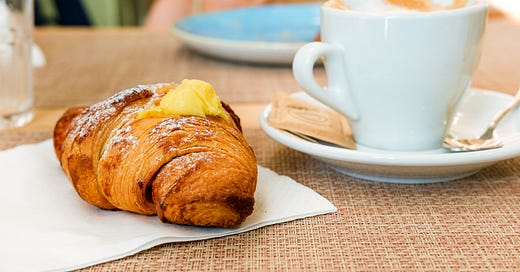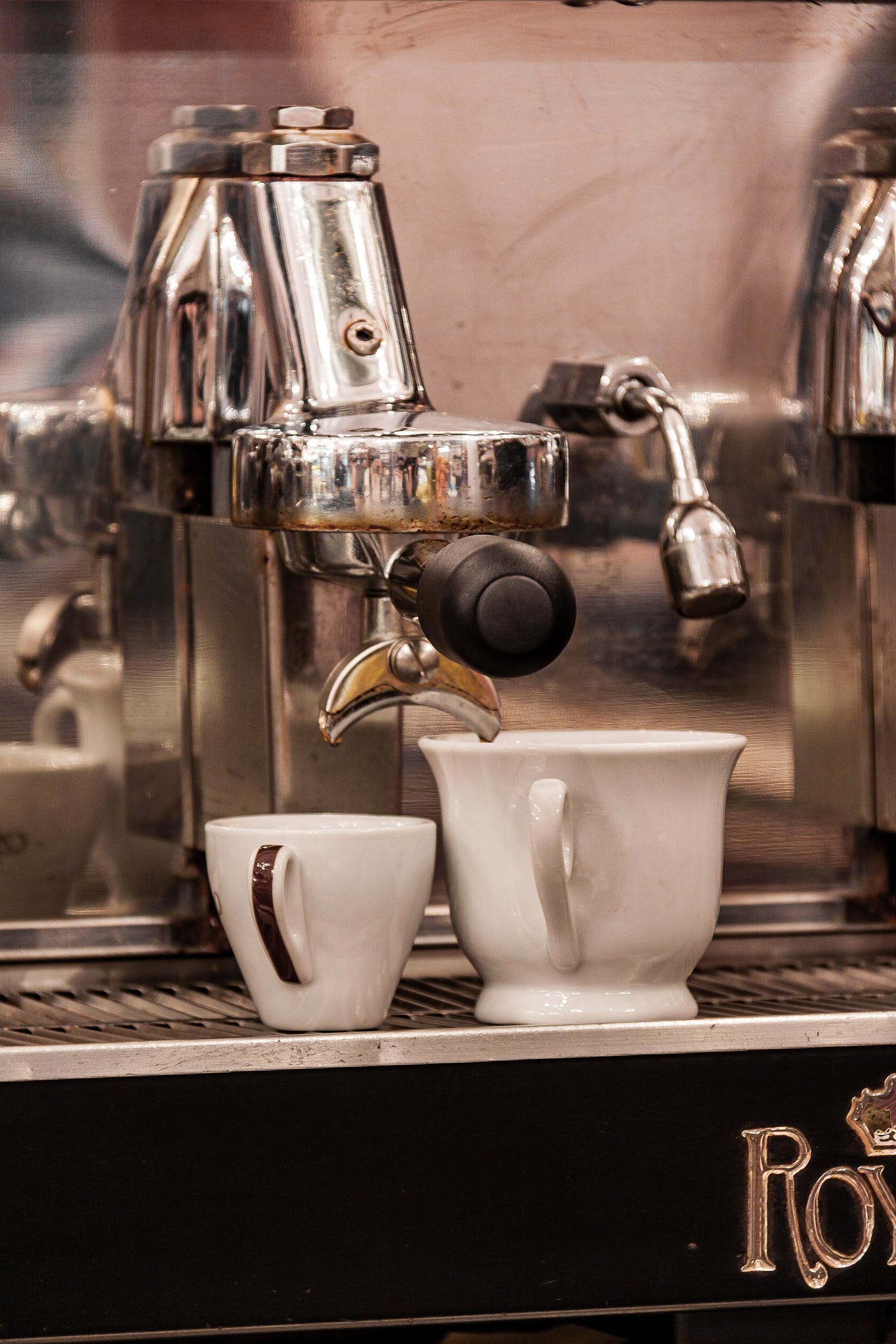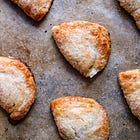How to breakfast like an Italian
The simplicity, speed, and rituals of an espresso and cornetto breakfast
The new season of cooking classes has just begun. For the Market to Table Cooking Class we stop at the local café to fuel up with espresso and croissant before we hit the market. This is when we get to know each other and start planning our menu for the day, but also when I can introduce the first meaningful aspects of the Italian life.
While we sit at a side table, a choreographed dance of customers happens in front of our eyes. The clinking of espresso cups and teaspoons, the yelled orders—tre caffè, un macchiato, un cappuccino con poca schiuma—, and the hiss of the coffee machine are the soundtrack of our morning rituals.
I’ve been meaning to share the rituals of the Italian breakfast at a local café for a while, so that the next time you’ll be visiting Italy you’ll be able to mingle with the locals while ordering a macchiato in tazza grande con un budino di riso.
An Italian Breakfast
Italians are often depicted sitting around a crowded dinner table, sharing food, conversation, and laughter, and lingering long after the meal, oblivious to the passing of time. Empty dishes are scattered about, along with wine glasses and espresso cups.
Indeed, there’s a saying that perfectly describes this habit: “a tavola non si invecchia,” meaning “you never grow old at the table.” That might explain why we seem to never want to leave.
Breakfast, however, is a different story.
First of all, when we do not have breakfast at home, we stop at a bar—no, not that kind. What we call a bar in Italy is the equivalent of a café. So don’t be surprised if an Italian friend asks to meet at the local bar at 8 a.m. for a drink—that means a coffee!
While lavishness, slowness, and calm describe a typical Italian meal, the first words that come to mind to describe breakfast at a bar are simplicity, speed, and ritual.
Even though Italy is usually considered the land of good coffee, I’m afraid to be a bearer of terrible news.
The coffee you can get in most places—especially restaurants—is often of poor quality, either burnt or too acid. Italians gulp down espresso after espresso as a social ritual or habit, without noticing how bad it actually is most of the times. In recent years a new wave of coffee appreciation has brought many new spots on the scene where you can get carefully brewed coffee, or specialty coffee, a term typically related to a deeper attention to the entire supply chain, using single origin or single estate coffee.
If you happen to be in Florence, you might want to try Ditta Artigianale.
Simplicity and Speed
The Italian breakfast is quick, something to fuel you up before getting into the office—or to cheer you up mid-morning, in between two meetings.
During the morning rush hour, approaching the counter of a bar can be an intimidating ordeal. Everyone is shouting orders at the barista, trying to make themselves heard over the clattering of cups, the conversation of other customers already enjoying their orders, and the noise of the giant, shiny espresso machine, churning out espressos, cappuccinos, macchiatos, and ristrettos with precision and speed.
Once you manage to place your order, grab something to eat, too, ideally your favorite sweet pastry—Italians have a sweet tooth in the morning.
As you will notice, Italians rarely sit down at the tiny tables scattered around the café. Follow their lead and stand at the counter, espresso cup in one hand and pastry in the other. It’ll be over in a matter of minutes, as you're expected to quickly yield your spot to the next customer.
Lately, though, the Italian breakfast scene has been changing. Through traveling abroad, we’ve come to appreciate the pleasure of sitting down in a café for breakfast, so now you’ll see more and more Italians meeting at a bar and enjoying their espressos and pastries sitting at those little tables. Still, this is not common among the majority of people, especially during peak hours, when everyone is rushing to work.
Ritual
Having your coffee at the bar is also a ritual, something Italians can’t do without. It’s always the same drink, the same pastry, at the same place every morning for years, so that after a while, you become a regular. The barista will recognize you from afar, nod at you, and make you il solito, the usual, without you even needing to ask.
I started drinking coffee during my first year of university when I would meet up with other students at a bar near our campus. That is when I came to see having an espresso as a social ritual—more than a necessity, or even a pleasure.
Before that, I used to order a hot tea with a lemon wedge along with my pastry whenever I would stop at a café with my mum. Now picture a 19-year-old Giulia trying to nonchalantly drink her cup of steaming hot tea at the counter, scalding her tongue and cheeks, while her friends had already gulped down their espresso and were ready to get back to the library.
So my change of habits happened not for the flavor of coffee (I did not even like it at the beginning, so I would fill up my espresso cup with sugar), nor for the mid-morning boost of caffeine (however needed it was). It was mostly a social demand, an excuse to meet with other people, share a coffee standing at the counter, and have a five-minute chat before our next class.
As with every ritual, there are rules for how and what to order. For Italians, this is something built into our DNA. For non-Italians, here is a little help.
What to Drink
This is just a small selection of the kinds of coffee you can get at an Italian bar. Aside from coffee, you can also order tea (though I do not recommend trying to gulp down a steaming cup at the counter, as I did for years before converting to espresso), freshly squeezed orange juice, or bottled fruit juice.
Espresso (Caffè): This is the simplest order. You’re meant to drink it in two or three sips, and it is usually steaming hot; a cold espresso means it has been sitting on the counter for too long.
Sometimes you can ask for your espresso “al vetro,” brewed directly into a glass: coffee connoisseurs say the flavor of an espresso is even better from a glass cup. You can add your sugar directly from little sachets of sugar at your disposal on the counter, should you need it.
Caffè Ristretto: A ristretto is an extra short espresso that you drink in a single sip, almost like a shot. This is as intense as it gets.
Caffè Lungo: On the opposite end of the spectrum, a caffè lungo is a long espresso, slightly less intense (in flavor, not in caffeine, as we said). Mind you, it is still served in a regular espresso cup, so it still only takes a few sips to finish.
Cappuccino: This is one of the most beloved ways of having coffee in Italy. A cappuccino cup is larger than an espresso cup, so as to fit a regular espresso, some hot milk, and a good cap of foam. This is usually what people get for breakfast along with their pastry.
While espresso is good for any time of day, including after a meal, unwritten rules limit drinking a cappuccino to before 11am, as we strongly associate it with breakfast. If you order one later in the day, you might still get it, but it will come with a strange look from the barista.
It is strongly recommended not to order a cappuccino after a meal, however, as the milk will make it too heavy and weigh down your digestion. Spend some time in Italy, and you’ll notice we Italians take proper digestion very seriously!
My two cents? order what you want! Once I asked for a macchiato after dinner in a pizzeria and the waiter replied: do you want also a croissant with your coffee? I was tempted to say yes, with jam, please.
Caffè Macchiato: If an espresso is too strong for you, but you do not feel brave enough to order a cappuccino after the morning, try a macchiato, good for any time of day. Macchiato, meaning “stained,” is an espresso with just a drop of hot milk and a bit of foam. If you’d prefer a cold drink, try ordering a macchiato freddo, for an espresso with a splash of cold milk instead.
Macchiatone: it sits between macchiato and cappuccino. It comes in a bigger cup than a macchiato, but it has less milk than a cappuccino. This used to be my coffee of choice before I converted to orzo (see below).
Latte: This is the main source of misunderstandings for native English speakers at an Italian bar. Latte is Italian for “milk,” so an order for a latte will get you just that: hot milk, with a bit of foam, usually served in a tall glass. For a splash of espresso added to the milk, order a latte macchiato.
Caffè Decaffeinato: This is a decaf espresso; you can ask for a decaf macchiato or cappuccino, too.
Caffè d’Orzo: If you do not feel like having a coffee, try a caffè d’orzo, which is made with roasted barley. It is very similar to coffee in flavor, but with a milder, sweeter taste and no caffeine. It usually comes in a slightly bigger cup, sometimes garnished with an orange twist. You can ask for a macchiato or a cappuccino d’orzo, too. Very common in restaurants after dinner if you feel like having something warm but do not dare drinking a coffee.
Caffè Shakerato: When summer comes, this drink is something I really appreciate. A shakerato is an espresso shaken with sugar syrup and ice, which makes it thick, frothy, sweet and bitter at the same time. It’s incredibly refreshing, and definitely made for sultry Italian summers.
Local specialties.
There are also local specialties that usually do not cross the borders of a town or a province. They might have very peculiar names, a way of serving espresso unique to that area, or a pairing dictated by local traditions. We go from the coffee granita with cream in Sicily to bicerin in Turin.
Moretta fanese: Even though I would not recommend this for breakfast, a moretta is a typical way of serving espresso in Fano and neighboring towns, in Le Marche region. A true moretta is distinguished by its three typical layers (starting from the bottom): liqueur, espresso, and espresso cream. When it comes to liqueur, it is a very unique blend of rum, aniseed liqueur and brandy, where aniseed is the distinctive flavor.
Caffè in ghiaccio con latte di mandorla: Literally, espresso over ice with almond syrup. This is the most typical coffee you can get in Salento in the summer. You’ll be brought a glass with precisely five ice cubes and a shot of milky almond syrup on the bottom. Along with it will come a properly brewed espresso, to pour over the ice cubes once you’re ready to enjoy it. Pour, stir with a spoon, and drink—the potent flavor of the coffee is the first to hit your senses, then the sweetness of the syrup with its notes of amaretto, and finally the chill of the ice cubes, which rest on your lips and send shivers down your spine. It’s a guaranteed instant wake-up.
Do you know other local coffee drinks that you tried in Italy? Or unique ways of serving coffee? Let me know in the comments!
What to Eat
Once you have sorted your caffeinated order with the barista, choose your favorite pastry from the window next to the coffee counter. These are the most common choices.
Cornetti: We could call these buttery crescents “Italian croissants, but you’ll realize how different they are from the first bite.
Although both are flaky, layered pastries, made with a laminated dough, Italian cornetti have more sugar in the dough, along with eggs, vanilla seeds, and orange peel. These unique ingredients make cornetti sweeter, softer, slightly denser, and more aromatic.
Thus, although you can pair a croissant with ham and cheese, you cannot do the same with a cornetto. The sweet pastry is better enjoyed plain, simply dusted with icing sugar, or filled with pastry cream, jam, or a chocolate spread.
Budini di Riso: These are rice pudding tartlets, with a crumbly shortcrust pastry shell. They used to be my favorite as a child, and I have still a soft spot for them. Enjoy them slightly warm, heavily dusted with icing sugar.
Bomboloni: These are big, heavy fried doughnuts, coated with sugar and usually filled with pastry cream or chocolate—a dream. Many bars fry up fresh batches twice a day, and indicate the hour on their window. I have a recipe for bomboloni on the blog.
Sfoglie: These are puff pastries, shiny with caramelized sugar. They can be filled with rice pudding, just like budini di riso, or stewed apples, jam, or pastry cream.
Local Specialties.
As for the coffee, each region also has local specialties that represent the go-to choice for locals and passers-by: think about maritozzo with cream in Rome, sfogliatella in Naples, or focaccia in Liguria.
Pasticciotti: When in Salento, you must go for a pasticciotto. The traditional pasticciotto, oval-shaped, with a glossy shortcrust shell and a thick pastry cream filling, was born in the town of Galatina, in the Salento region of southern Italy. Now, it has become one of the most iconic products of the entire region.
Erbazzone reggiano: erbazzone reggiano, a savory pie stuffed with chard, onion, garlic, and a generous amount of grated Parmigiano Reggiano, is what I eat for breakfast when I visit my friend Valeria in Reggio Emilia. Order a square of erbazzone and a cappuccino to eat like a local! (You can find the recipe in Cucina Povera, page 83)













I think you left out "a latte." Most Americans think they know what that means. Most Americans are stunned to get a glass of, usually, tepid milk.
Going to Italia next week! Looking forward to breakfast!